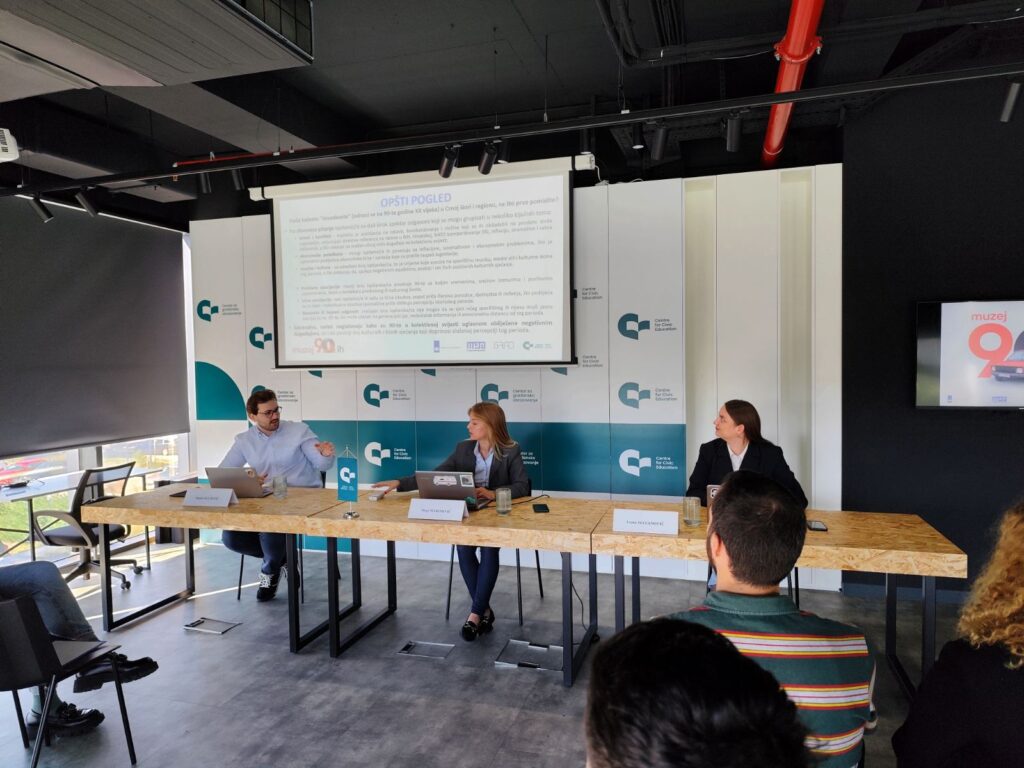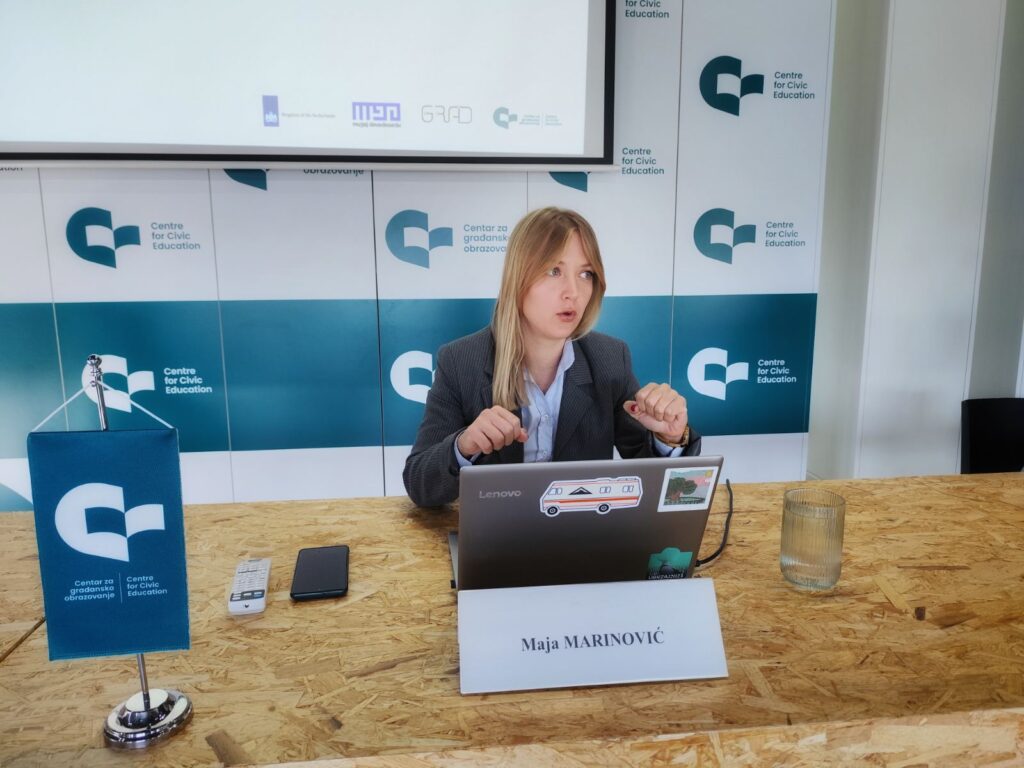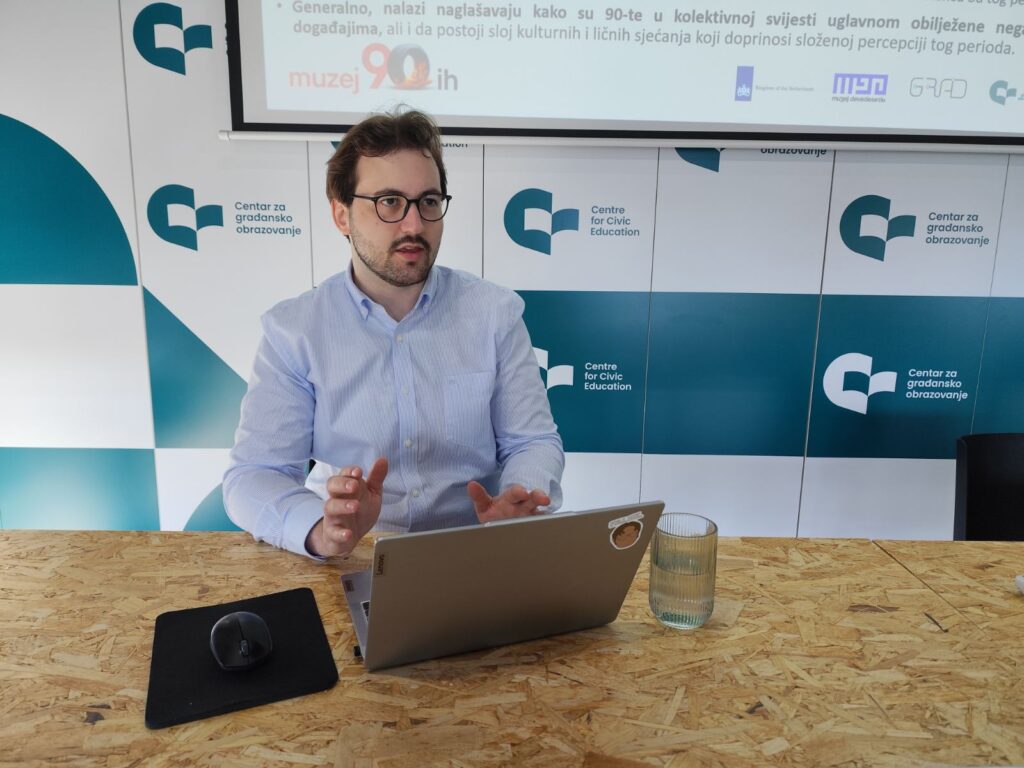“The 1990s are primarily marked by negative events and corresponding negative emotions in the collective memory of young people in Montenegro, although there is also a layer of cultural and personal memories that make the perception of this period complex. The dominant belief is that this period is significant for our society, but this is not matched by adequate knowledge, especially due to shortcomings in the formal education system,” are some of the findings from the research presented today by the Centre for Civic Education (CCE) on the knowledge of facts and attitudes of young people about the 1990s in Yugoslavia. The research is part of the project Museum of the 90s – A Regional Centre for Reconciliation, Education, and Future Cooperation, implemented by the CCE from Montenegro and Cultural Front from Serbia, with support from the Dutch Ministry of Foreign Affairs.
“Respondents most often associate the 1990s in Montenegro and the region with wars and conflicts, economic difficulties, but also with certain music and culture, which indicates a complex, albeit mostly negatively coloured, perception of that period. A significant number did not have a clear association with the ’90s, which may indicate a generational gap, lack of information, or emotional distance from that time,” stated Maja Marinović, Programme Associate at the CCE and coordinator of the Museum of the 1990s project for Montenegro, introducing part of the findings.
“Young people’s knowledge about the 1990s in Montenegro and the region is limited, fragile, and relies on informal sources, primarily stories from parents, their immediate surroundings, as well as media and social networks, while formal education plays a much smaller role as a source of information,” she further explained.
As part of the research, respondents expressed their views on issues such as responsibility for the wartime events, the work of the Hague Tribunal, attitudes toward NATO, and provided a general overview of the 1990s.
“The prevailing belief among young people is that individuals, not nations, are responsible for crimes during the wars of the 1990s, but there is also a perception that their nation suffered the most during these wars. Young people generally agree that the final judgments of the Hague Tribunal must be respected, with moderate agreement regarding the fulfillment of its primary goal of this court in the part of prosecuting those most responsible for war crimes and perceived selectivity in its work. Most young people believe that NATO committed aggression against the Federal Republic of Yugoslavia, and to a significant extent they also believe that NATO committed crimes during the bombing of Montenegro. Finally, the dominant view is that the ideologies and policies that led to war conflicts and crimes during the 1990s still exist in Montenegro, along with significant support for prosecution od Montenegrin citizens who committed war crimes,” said Marinović.
The dominant view is that young people should learn about the 1990s during their formal education, which has not been the case for most, although those who did study this period in the formal education system are generally satisfied with how it was taught.
“Most young people, who learned about the 1990s in school, learned about the NATO bombing of the FRY and the war in Kosovo, as well as the war in Bosnia and Herzegovina, while the least studied about the operation “Flash” and the Kumanovo agreement. There is a significant percentage of those who are unsure or do not know if they learned about certain events,“ Marinović emphasized.
“Two-thirds of the young respondents belive that Montenegro participated in the wars of the 1990s on the territory of the former Yugoslavia, while about a fifth believe the opposite, and another fifth are undecided about this issue,” said Damir Suljević, coordinator of the Human Rights Programme in CCE.
“Slightly more than half of the young people state that they heard about the attack on Dubrovnik in October 1991, and the majority of them believe that the attack was not a justified military action. Among the young people who heard about the attack on Dubrovnik, nearly two-thirds do not know how many Montenegrin citizens died there,” said Suljević.
The research also indicates that the largest number of those who do not know or refuse to answer the question whether there were war crimes on the territory of Montenegro (42.2%). Among the youth who answered that question affirmatively (38.6%), most had heard of the Deportation case (47.2%) and the Štrpci case (45.6%), with the fewest aware of the Klapuh family (22.8%).
“A large number of respondents – 73.8% – are familiar with the events in Srebrenica, and when asked whether genocide was committed in Srebrenica, 66.9% answered affirmatively, 14.6% negatively, and 18.4% did not take a position. Among those who deny the genocide in Srebrenica, three main lines of thought emerge – that it was a war with casualties, that it was a crime but not genocide, and there are also those who completely deny the events and consider it a conspiracy, such as claims that it was all staged,” explained Suljević.
“The number of young people who have not heard of the military operation Storm in 1995 is similar to those who have (around 40%). Among those familiar with Storm 61.7% believe that the operation was a joint criminal enterprise, as stated in the verdict of the Hague Tribunal. Regarding the Lora case, 57% of young people are unfamiliar, 17% are aware, and 26% are undecided,” Suljević added.
Four fifths of young people are familiar with the NATO bombing of the FRY, but the majority among them do not know or refuse to answer the question about how many people were killed in Montenegro during the NATO bombing.
Total of 63.2% of young respondents have not heard of the anti-war movement that existed in the region in the 1990s, and 68.8% of them are unfamiliar of the anti-war movement in Montenegro.
The research also showed that young people are limitedly informed about the culture of monuments dedicated to the victims of the wars of the 1990s, both in the region and in Montenegro.
Most young respondents are unsure or refuse to answer whether Montenegro has confronted its wartime past from the 1990s, while among those who did answer, slightly more believe that the country has confronted its past (30.8%) compared to those who think it has not (28.4%).
“The majority of respondents (44%) support the process of dealing with the war past of the 1990s in Montenegro, but there is also a significant number of young people who do not support it (26.0%) or have no opinion (30%),” emphasized Suljević.
When asked if they knew whether any Montenegrin citizens had been charged with war crimes committed either in Montenegro or elsewhere during the 1990s, the majority did not know the answer.
The research was conducted from 17 to 23 September 2024, using the CAPI method, with a stratified random sample of 500 respondents aged 18 to 25. The Institute DAMAR provided expert support in conducting this research.
Ivana Matanović, Project Assistant



